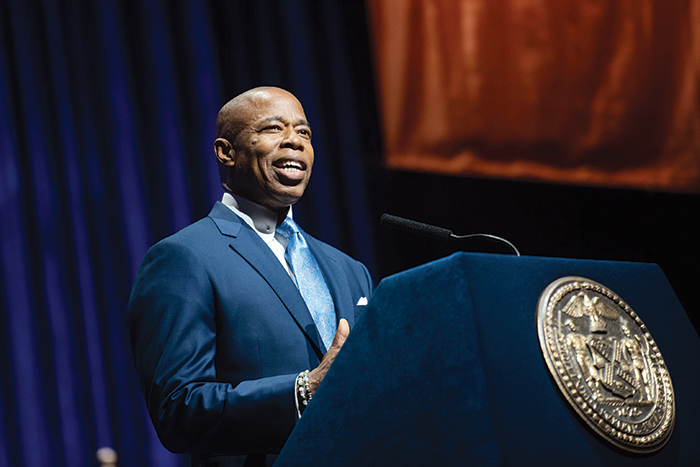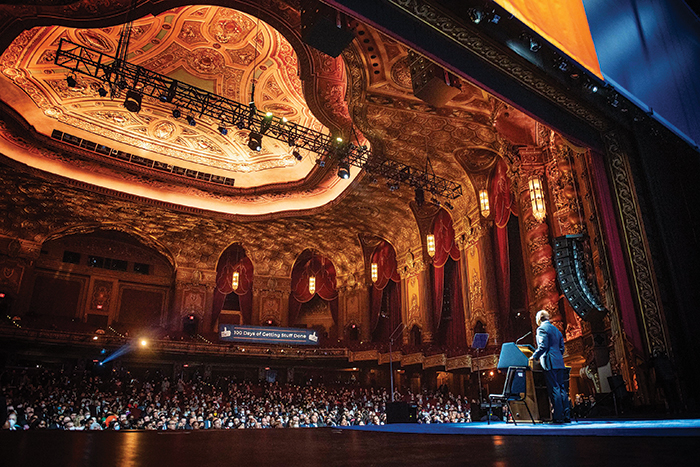Photo Courtesy of Michael Appleton/Mayoral Photography Office
Hizzoner delivered his first State of the City address on Tuesday at the historic Kings Theatre in Brooklyn.
By Michael V. Cusenza
Mayor Eric Adams on Tuesday outlined an ambitious vision for the five boroughs in his first State of the City address, delivered at the historic Kings Theatre in Brooklyn.
In his remarks, the mayor reviewed his first 100 days in office and previewed his plans to promote an equitable recovery, lift up the city’s youth, invest in 21st century infrastructure, and create a safer and more just NYC.
A busy Adams also unveiled a balanced, $99.7 billion Fiscal Year 2023 executive budget, which, he said, combines upstream investments with fiscally responsible measures, including budget reserves at $6.3 billion—the highest level in City history.
Highlights of Hizzoner’s first State of the City address include:
CREATING A SAFER AND MORE JUST CITY
Mayor Adams has repeatedly stressed that public safety and justice are the prerequisites to prosperity and must go hand in hand. In January, he rolled out his “Blueprint to End Gun Violence,” laying out concrete steps at the city, state, and federal level to dam the rivers that feed the sea of gun violence. The following month, he released the “Subway Safety Plan,” a multiagency effort in partnership with the state to address public safety concerns and connect unhoused people and those struggling with serious mental illness with the supports they need.
As part of the city’s effort to address the ongoing crisis of gun violence, the City Police Department in March began to deploy Neighborhood Safety Teams to the areas that account for 80 percent of all shootings citywide. As a whole, the NYPD has removed nearly 2,300 guns from the streets since Mayor Adams took office.
To build on these important steps, Adams on Tuesday announced additional resources for the Subway Safety Plan, including $55 million in FY23 to expand the Behavioral Health Emergency Assistance Response Division (B-HEARD) initiative — which deploys mental health professionals instead of law enforcement to respond in certain cases to people experiencing mental health crises — to Central Brooklyn, Eastern Queens, and currently uncovered areas in the South Bronx. The administration also plans to propose $171 million in FY23 to add 1,400 new Safe Haven and stabilization beds by mid-2023 to help unsheltered New Yorkers transition off the streets and out of the subway system into more stable housing.
PROMOTING AN EQUITABLE RECOVERY
More than two years after the first COVID-19 case was identified in New York City, the city continues to face an uneven recovery. Mayor Adams is committed to building an equitable, inclusive recovery for all New Yorkers — one that directly addresses the longstanding inequities that were exacerbated by the pandemic. Several weeks ago, he joined elected officials and community leaders to celebrate the enhancement of the Earned Income Tax Credit (EITC) in the state budget, fulfilling his campaign pledge to bolster the social safety net and expand services for working families in New York City. More than 800,000 families will benefit from this EITC increase, supported in part by a $250 million annual commitment by the city. And last month, the mayor unveiled his “Renew, Rebuild, Reinvent: A Blueprint for New York City’s Economic Recovery,” which proposes 70 concrete initiatives to revitalize the city’s economy and get New Yorkers back to work.
A key recommendation advanced in the report called for doubling down on investments in the burgeoning life sciences industry. To that end, Adams today announced a major new partnership with Taconic and DivcoWest, together with New York University, to bring new space to 455 First Avenue that will support cutting-edge research, entrepreneurial training programs, and workforce development. The city is also working to bring new space online at the Alexandria Center, completing the last of three life sciences towers that have anchored the industry for over a decade. Together, these two projects will nearly double lab space in the Kips Bay neighborhood of Manhattan, helping cement it as a major hub for the life science industry in New York City.

Photo Courtesy of Michael Appleton/Mayoral Photography Office
“We’ve been through a lot. We have struggled and survived,” Mayor Adams said.
In addition, the administration is committing $140 million in capital funds beginning in FY23 for the Hunts Point Produce Market, which supplies 25 percent of the city’s fresh produce. The funding, another key component of the economic blueprint, will help improve the surrounding infrastructure and neighborhood parks at the facility. Mayor Adams also announced $5 million in FY23 to help the City University of New York train students for the most in-demand skills and connect them to good jobs at companies that are hiring, including high-growth sectors like life sciences, the green economy, technology, and advanced manufacturing.
LIFTING UP NYC YOUTH
Adams said he’s committed to providing greater support for families and young people, who represent the future of New York City. Thanks to the administration’s leadership, Governor Hochul and state lawmakers agreed to historic investments in child care in the most recent state budget. In addition to committing $4 billion toward expanding affordable childcare for New Yorkers, new city tax incentives authorized by the state will spur the creation of up to 17,000 new child care seats in New York City.
In order to ensure child care is affordable and accessible for working families in New York City, Mayor Adams announced that new rates will go into effect in June that will dramatically reduce the fees that eligible families currently pay for subsidized care. The administration is also committed to reducing the bureaucratic hurdles families face when seeking child care, which is why Mayor Adams also revealed that the first major application of the mayor’s proposed “MyCity” platform will be a single, unified application process for all subsidized child care options offered by the city.
Children of all ages in the city have been significantly impacted by the disruptions stemming from COVID-19. As New York City students continue to struggle with learning loss due to the pandemic, Mayor Adams is committing $101 million in FY23 for summer activities for 10,000 more K-12 students in the Summer Rising program, which provides hands-on summer learning and enrichment courses to strengthen students’ academic, social, and emotional skills. This investment brings the number of slots funded by New York City Department of Youth and Community Development to 110,000, for a total program capacity of 210,000 slots.
Adams is also committed to giving students with learning disabilities the tools they need to succeed. Today, he unveiled an unprecedented investment of $7.4 million in FY23 to fund new dyslexia screening sites and literacy programs. Mayor Adams also announced $33 million for the New York City Department of Education to launch new career pathways programs starting this September focused on high-growth sectors like health care and technology.
INVESTING IN 21ST-CENTURY INFRASTRUCTURE
New York City’s built environment is constantly changing. As the city confronts new challenges, Mayor Adams believes the city must adopt a people-centered approach to infrastructure — especially for New Yorkers who have historically been underserved by critical infrastructure needs. Earlier this week, he announced a historic investment of $904 million over five years — nearly $580 million in capital funding, as well as expense funding that ramps up to more than $65 million annually, or $327 million over five years — to advance the goals laid out in the “NYC Streets Plan” and rapidly build out critical street safety and public transportation infrastructure.
Accessing affordable, quality housing consistently ranks among New Yorkers’ top concerns. That is why Mayor Adams announced that the city is making the largest-ever commitment to housing in the city’s history. The FY23 executive budget proposes $5 billion in capital funding to promote the creation and preservation of affordable housing. This includes investing in the New York City Housing Authority Permanent Affordability Commitment Together program, as well as funding major in-unit repairs at Gowanus Houses and Wyckoff Gardens that Mayor Adams advocated for as Brooklyn borough president.
Public spaces have become vital lifelines during the pandemic. Parks and green spaces not only provide important physical and mental health benefits but also are critical tools for promoting environmental justice. That’s why Adams’ FY2023 executive budget provides $488 million in capital funding for park-improvement projects, he noted, including planting 20,000 trees annually in the coming years to reduce citywide heat vulnerability, enhancing and adding new greenways in Brooklyn and Queens and rehabilitating critical infrastructure, including pools. This new investment — combined with other funding to enhance and expand green space across the city — represents a down payment on the mayor’s “One Percent for Parks” pledge and showcases his commitment to parks equity.
“The state of the city is strong. Because New Yorkers have never been stronger,” Adams said. “We’ve been through a lot. We have struggled and survived.”

